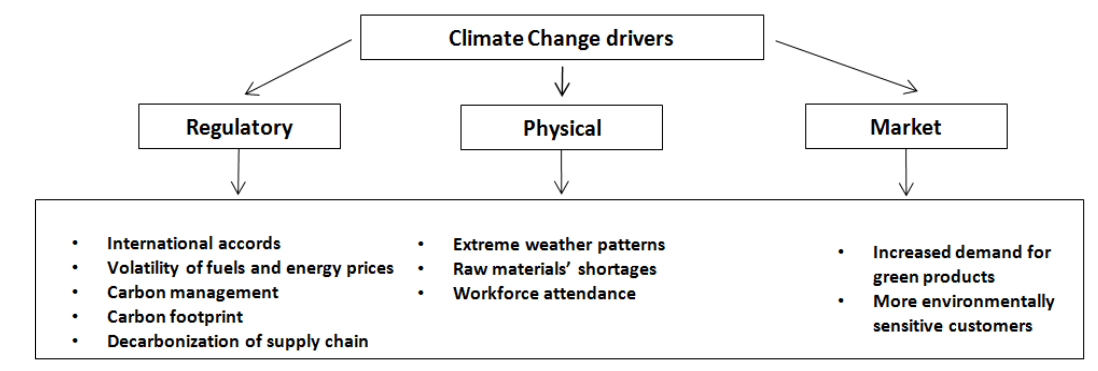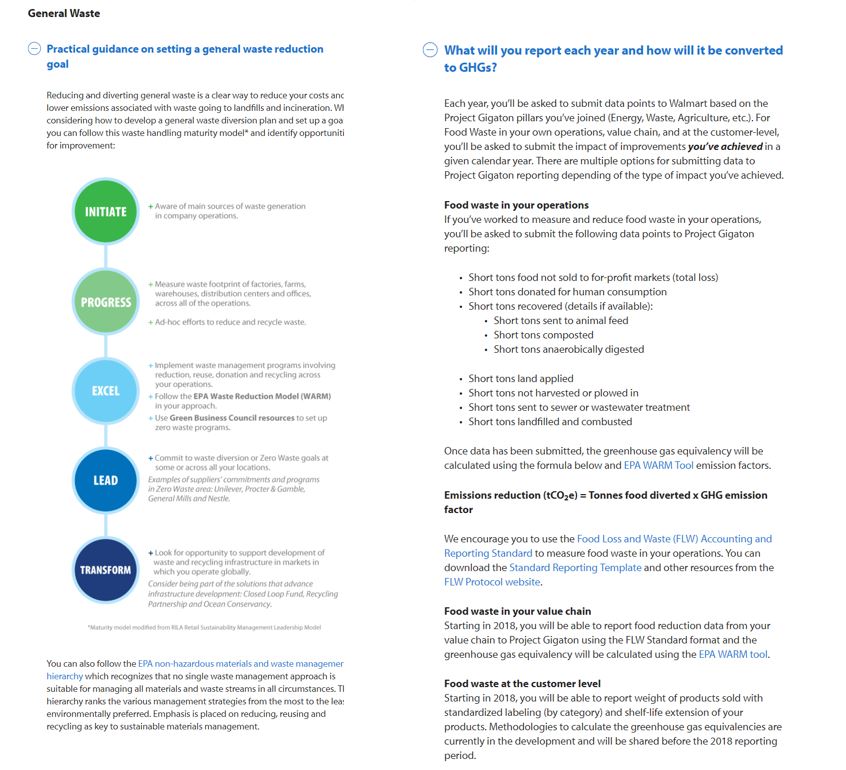Walmart Sustainability Hub, the “village” for Climate Change aware companies that want to save the planet

Walmart wants its own supply chain to reduce GHG emissions by 1 Gigaton, the equivalent of removing the annual emissions of Germany — the world’s fourth-largest economy — from the atmosphere. Will everyone follow?
“Walmart, the world largest retailer, has launched an initiative to remove 1 gigaton of greenhouse gas emissions (GHG) from its supply chain by 2030. To put that in perspective, that is the equivalent of removing the annual emissions of Germany — the world’s fourth-largest economy — from the atmosphere.” [1]
Climate change is certainly one of the most urgent issues of our time. While it is easy to understand the ethical reasons to reduce GHG emissions to impact climate change, there are two main reasons why reducing GHG emission is also a great business opportunity:
• “supply chains are vulnerable to risks and potential costs associated with the physical and regulatory threats related to global climate change” [2];
• “Managing greenhouse gas emissions has also been shown to enhance brand and market value in some circumstances” [2].

The Sustainability Consortium stated that the modern supply chain is responsible for 60% of all greenhouse gas emissions, 80% of all water use, and 66% of all tropical deforestation.
Walmart took the lead on GHG emission reduction in 2005, setting three main goals: create zero waste in company operations, operate with 100% renewable energy, sell products that sustain the environment. In the last few years, Walmart invested in alternative energy, particularly solar, creating thousands of job opportunities for American solar companies, and now obtains 25% of its energy from renewable sources. It also doubled the emission efficiency of the US fleet, achieving an emission reduction of 650,000 metric tons of CO2, saving nearly $1 Billion in 2015 [4]. But most important, Walmart managed to be the first retailer with an emission-reduction plan approved by the Science Based Target Initiative, that complies with the Paris Climate Change Agreement of December 2015. Under this plan, Walmart committed to aggressive long-term goals:
• 18% emission reduction in the operations between 2015 and 2025 [4];
• Work with suppliers to reduce emissions by 1 Gigaton by 2030 [4].
This second goal is particularly ambitious. Walmart will need to engage the thousands of companies involved in its supply chain. To do this, it created the Walmart Sustainability Hub, an online platform that gathers a community of suppliers willing to accept the challenge.

In this platform, Walmart explains the project goal, why it decided to focus on particular areas, the so-called “pillars” (emissions, energy, agriculture, waste, packaging, deforestation, product use and design) and how it encourages suppliers to participate (Figure 3).


For example, for waste, the toolkit includes:
• Benefits of reducing waste (e.g., reduce costs, increase efficient use of resources, reduce GHG emissions) [5];
• Relevant goals that companies might set (e.g., “divert 80% of solid waste in your operations by 2030”) [5];
• Practical guidance on setting goals (e.g., guidelines to develop a general waste diversion plan, and opportunities for improvement for each step, see Figure 5 for details) [5];
• Guidelines to report your progress annually [5].

Moreover, suppliers are asked to contribute to the hub if they have alternative solutions to reduce any of the pillars.
Walmart’s action is certainly bold, it demonstrates unparalleled vision and leadership in the industry. The Hub provides toolkits, information, and, most important, a Hub to grow a community. However, a critical step of this process is convincing companies to make a big change in their operations to achieve long term benefits. Retail suppliers are traditionally skeptical about change, especially if that requires significant capital expenditures. For this reason, Walmart has room to improve its strategy to convince suppliers.
For example, additional economic incentives guaranteed by Walmart to its suppliers would make them more eager to embrace the project. Furthermore, the Hub offers great support for the first steps of the project (commitment and execution), but limited resources are available for scaling, which is probably the hardest part of the implementation process.
“Companies are not shrinking in the face of potential political opposition to climate goals—they’re doubling down” said Carter Roberts, CEO of World Wildlife Fund [6]. Is this true? How many companies will be willing to leave their comfort zone, challenge Washington’s political view about the issue, and start their sustainability journey? An initiative of this magnitude will take a village to execute. Will this village grow fast enough to reach such an ambitious goal?
Word count: 800 words
Bibliography:
[1] Elizabeth Sturcken, “Why Walmart’s Project Gigaton is corporate America’s ‘moonshot’”, Greenbiz, April 19, 2017, [https://www.greenbiz.com/article/why-walmarts-project-gigaton-corporate-americas-moonshot].
[2] Chonnikarn (Fern) Jira, Michael W. Toffel, “Engaging Supply Chains in Climate Change”, Harvard Business School, March 1, 2013, sec. 1, p. 1.
[3] Thomas K. Dasaklis, Costas P. Pappis, “Supply chain management in view of climate change: An overview of possible impacts and the road ahead”, University of Piraeus, March 1, 2013, sec. 1.
[4] Walmart company. “Company Overview”. https://news.walmart.com/2017/04/19/walmart-launches-project-gigaton-to-reduce-emissions-in-companys-supply-chain, accessed November 2017.
[5] Walmart Sustainability Hub, “ https://www.walmartsustainabilityhub.com, accessed November 2017.
[6] Matthew Boyle, “Walmart’s wants suppliers to Eliminate a Gigaton of greenhouse gases by 2030”, Bloomberg, April 20, 2017, [https://www.bloomberg.com/news/articles/2017-04-20/wal-mart-wants-suppliers-to-eliminate-a-gigaton-of-greenhouse-gases-by-2030]



Great to see Walmart leading the charge here. It is promising that they are looking at this as not just an environmental and regulatory issue but one that can have economic benefits for their company. I am even more impressed that they have engaged their suppliers in the process to make sure that this permeates through the entire supply chain. That being said, I think MD recognizes the correct challenges that without immediate economic benefits, it might be unlikely that these companies will join the climate change battle. Companies often think so short term on when it comes to these things and changing to be more sustainable will certainly involve cost in the short term. I think Walmart can do even more education, and potentially use more of a stick method, to get more of its suppliers onboard.
I think it’s great that the company is taking the initiative here to influence others in its supply chain to do the same. Sure, it might be difficult for Walmart to get suppliers on board with understanding the short vs long term economic benefits, but as one of the largest companies in the world, we shouldn’t underestimate the amount of clout Walmart has over its suppliers. For many of its suppliers, Walmart is likely the largest customer contributing to the majority of revenues. As a supplier in that situation, if Walmart wants you to change certain aspects of your supply chain and how you’re delivering product to Walmart, it’s in your best interest to do what they want.
Hopefully more and more companies will embark on such journeys towards sustainability. As pointed out, doing this can lead to a market advantage and elimination of certain regulatory risks, but I would like to believe that a big part of this effort is done based on the recognition of how serious climate change issues are. So although there will always be companies that will choose the easiest and cheapest way how to make money (gaming any regulations there already are or might be in the future, or just doing the bare minimum), I think more and more companies will organize their operations in sustainable ways in the future.
This initiative reminds me of Ikea’s People and Planet Positive sustainability strategy, which we learned about in our Ikea case. Assuming Walmart is able to scale this initiative, i.e. attract companies to its hub, what I really like about this idea is the sense of competition and shared moral obligation the open forum has the potential to create. By making it about community, or in this case a “village,” Walmart has the ability to be prescriptive through its toolkit but also create a dynamic tension among other companies by providing transparency around how companies are progressing. Of course there’s also the positive reinforcement piece with the “opportunity for recognition” as well as an opportunity for companies to learn from one another but I imagine companies will be more compelled to act by a sense of urgency derived from the perception that other companies are already further along.
Very interesting article! I was pleasantly surprise to learn that Walmart is making giant strides towards global reduction of green house gases (GHG) in its massive supply chain. We typically think of Walmart as a company that leverages its economics of scale to squeeze margins out of its suppliers. In this instance, Walmart is leveraging its economies of scale to influence UP the supply chain, incentivizing suppliers to adopt more sustainable practices. But can we assume that Walmart is acting completely with altruism? It costs Walmart very little to dictate new sustainability practices to its suppliers, yet Walmart is able to take all of the credit when it comes to the PR benefit. Moreover, when it comes to reducing packaging waste, there are additional lucrative benefits for Walmart reap in that less packaging presumably means smaller, lighter items that require cheaper transportation, less inventory cost, and more items that can fit into the shopping carts of its consumers. Nevertheless, while Walmart’s actions might not be entirely selfless, it is a win for the planet when Walmart’s profitability incentives align with sustainability practices.
I certainly agree that this is a very ambitious goal that Walmart has set itself up for! I really like the clarity of Walmart’s communication regarding its long term plans to public and its shareholders. One of immediate challenges for Walmart I could think of is to gain buy-ins from sufficient number of suppliers by incentivizing them economically. In order to sustain the momentum of making significant progress in this project, Walmart should also continue to invest in building a partner relationship with suppliers to help them develop clear and tangible set of goals with detailed action plans.
I commend Walmart for recognizing its footprint on the planet and for being an early proponent of the idea that you can increase profits and reduce emissions at the same time. I also commend them for moving away just from profitability and pushing the idea that modern industry has an extraordinary impact on the planet, and that firm executives need to move beyond simply meeting minimum regulation to help build the kind of future that they would want their children and grandchildren to live in.
Given Walmart’s massive buying power, to what extent can it move beyond its own operations and push its supply chain to become more sustainable? Would other firms join in the push? To what extent could Walmart create a halo around its brand by pushing sustainable products – would competitors like Target follow?